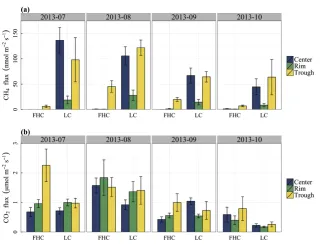Using measurements of surface methane and CO2 fluxes, concentrations and stable isotope compositions of methane and DIC at 3 depths in the soil, and soil moisture and temperature, this study identifies important predictors of methane emissions and microbial methane production pathway across a range of polygon types and features representing varying degrees of permafrost degradation. Averaged across all polygon features (centers, rims, and troughs), methane emissions from low-centered polygons were ~9 times as high as from flat- and high-centered polygons. While this pattern in methane emissions followed an overall soil moisture gradient, statistical results indicate that methane emissions depend on microtopographic position and polygon type to a greater degree than soil moisture could explain. Specifically, low-centered polygons with intact ice wedges had higher methane emissions, a greater contribution of acetate cleavage to methane production, and lower methane oxidation than did flat- and high-centered polygons. This relationship persisted even in the relatively dry rims of low-centered polygons and the saturated troughs of flat- and high-centered polygons. Vegetation surveys and results from Newman et al. (2015) and Liljedahl et al. (2012) provide evidence that differences in vegetation, geochemistry, and water flow among polygon types contributed to these observations. In contrast with many previous studies, these findings document a mechanism whereby loss of subsurface ice can lead to local decreases in tundra methane emissions.
References:
Liljedahl AK, Hinzman LD, Schulla J (2012) Ice-wedge polygon type controls low-gradient watershed-scale hydrology. In: Tenth International Conference on Permafrost, Salekhard, Russia.
Newman BD, Throckmorton HM, Graham DE et al. (2015) Microtopographic and depth controls on active layer chemistry in Arctic polygonal ground. Geophysical Research Letters, 2014GL062804.
Vaughn LJS, Conrad ME, Bill M, Torn MS (2016) Isotopic insights into methane production, oxidation, and emissions in Arctic polygon tundra. Global Change Biology (accepted).

Greenhouse gas emissions, classified by polygon type, position, and measurement month. (a) Net CH4 flux in nmol CH4 m-2 s-1 and (b) ecosystem respiration in mol CO2 m-2 s-1 were measured from each feature of 4 flat/high-centered (FHC) and 3 low-centered (LC) polygons. Standard errors were calculate
For more information, please contact:
Lydia Vaughn
lydiajsmith@lbl.gov

